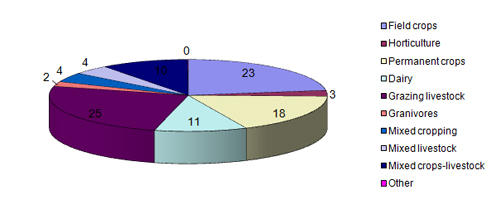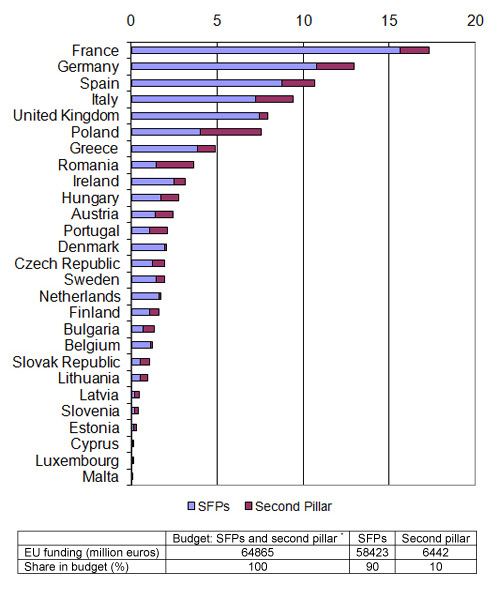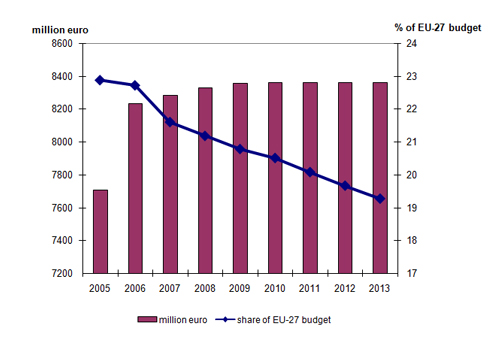France
• General country description
• A. First pillar: implementation of CAP reforms (2003)
• B. Second pillar: implementation of RDP measures during 2007-2013
• C. Vision for the CAP beyond 2013: a short overview of the debate (at Member State level) on future CAP reform
• D. Literature, sources, references
• The comparative analysis provides a compact overview of CAP implementation across all 27 Member States and their visions of the future of the CAP
General country discription
France |
Comparison with EU-25 |
Population, 2005 (*1,000,000): 60.8 |
13.2% of population in EU-25 |
Population density, 2003 (inh./km2): 112 |
118 in EU-25 |
GDP/capita, 2005 (PPS): 25,500 |
109% of GDP/capita in EU-25 |
Share agriculture in total employment, 2002 (%): 4 |
5% in EU-25 |
Share Utilized Agricultural Area in total land area, 2003 (%): 57 |
46% in EU-25 in 1998 |
Average farm size, 2005 (ha): 52 |
19 in EU-15 |
Number of farms, 2005 (*1000): 545 |
8.7% of farms in EU-25 |
Source: own calculations based on Eurostat
Distribution of farming types, 2005 (% of total)

Source: own calculations based on Eurostat
EU funding for the Single Payment Scheme (SPS)
and the second pillar, 2007-2013

Funding according to CAP budget including Bulgaria and Romania.
Sources: Agra Europe (2007); CEU (2006); EC (2007a)
A. First pillar: implementation CAP reform (2003)
A.1 Single Payment Scheme
Model
SPS historical (EC, 2007b)
Coupling measures
Complete decoupling, except for arable crops (25% coupled), sheep and goat premium (50% coupled), suckler cow premium (100% coupled), slaughter premium calves (100% coupled), slaughter premium bovine adults (40% coupled), seeds (some species), outermost regions (100% coupled), dairy premium in 2006.
Reason for selection
- no reallocation of historical distribution of payments in order to prevent income effects;
- partly coupling in order to maintain certain types of production;
- partly coupling in order to prevent land abandonment.
A.2 EU budget for Single Payment Scheme (SPS) per year (National ceiling) 2005-2013

Source: 2005: EC (2006); 2006-2013: CEU (2006) and Agra Europe (2007)
Share of the farms that receive SPS of the total number of farms (% of total)
No information
Tradability of SPS
- Single payments are tradable with or without soil.
- Single payments are only tradable within French departments.
A.3 Cross-compliance: Good Agricultural and Environmental Conditions (GAEC)
Source: IEEP, 2005
Selected standards of the GAEC
Issue |
Standards |
Summary of farmers’ obligations |
Soil erosion |
Minimum soil cover |
3% of cultivated area under environmental cover, if relevant adjacent to a watercourse and 5-10 m wide; no pesticide or fertiliser use. National legislation to make this standard more targeted. |
soil organic matter |
standards for crop rotation where applicable |
at least 3 different crops, each at least 5% of cultivated area. Incorporate crop residues into the soil. If not possible, winter cover or crop-waste management obligatory. |
|
arable stubble management |
>burning forbidden |
soil structure |
EXTRA: irrigation standards |
national legislation. Authorisation needed for pumping activity and restricted volume. To protect water resources and soil structure. |
protection of permanent pastures |
|
implemented at regional level; depending on degree of decrease, criteria defined on local level |
minimum level of maintenance |
avoiding the encroachment of unwanted vegetation on agricultural land |
EXTRA: management of invasive species |
|
EXTRA: set-aside management |
Set aside has to be maintained |
France focuses on all issues, mainly to protect water resources and soil. Contrary to other Member States, specific legislation on irrigation.
Reason for selection of cross compliance standards
GAECs are according to current national practices.
A.4 Further reform of market regulations
Decoupling of other products, like tobacco, hop etc.
10% deduction in olive sector for funding programmes by producer organisations, hops payments 25% coupled, Annex VII point H and I: olive oil coefficient for decoupling: 1; tobacco coefficient for decoupling: 0.4 (EC, 2007b).
B. Second pillar: implementation of RDP measures 2007-2013
B.1 Programme level and approval
There is one national strategy and there are six RDPs, one for Mainland France, one for Corsica and one for each French Overseas Department (Guadeloupe, Martinique, Guyana and Réunion). The Rural Development Committee (consisting of representatives of the 27 Member States) has approved the RDP for Mainland France on 20 June 2007, for Martinique and Réunion on 21 November 2007, for Corsica and Guyana on 20 December 2007 and for Guadeloupe on 24 January 2008.
B.2 Distribution of public budget over the axes (%)1)
|
axis 1: competitiveness |
axis 2: environment and land management |
axis 3: rural economy |
Axis 4: Leader |
Mainland France |
37 |
52 |
6 |
5 |
1) Figures excluding Technical Assistance
Source: Own calculations based on Ministère de l’agriculture et de la pêche (2007)
B.3 Integration of Leader in axes 1, 2 and 3
In Mainland France, the integration of Leader in one or more axes is not specified. Leader should contribute to the improvement of new approaches to governance and to the mobilization of the endogenous development of local sources and actors.
B.4 Local Action Groups (LAGs)
In Mainland France it is intended to create about 200 LAGs at maximum (compared to 140 LAGs in the previous period). These LAGs should cover at maximum about 55% of the rural area, compared with 42% in the previous period (2000-2006).
B.5 RDP budget 2007-2013 (million euros)
|
total public budget |
% co-financing EAFRD1) |
EAFRD budget |
Contribution private sector |
Total costs |
National top-ups |
Mainland France |
10842.2 |
53 |
5727.1 |
4079.6 |
14921.7 |
2907.0 |
Total France |
|
|
6442.0 |
|
|
|
1) % of co-financing may vary per axis
Source: Ministère de l’agriculture et de la pêche (2007)
B.6 Less Favoured Areas
In the RDP for Mainland France there is no mentioning of the number of ha that are designed as Less favoured Areas (LFA). In 2005 12,279,000 ha was designed as LFA (41% of UAA). About one third was mountain areas and two thirds were with handicaps other than mountain areas (CEU, 2005).
B.7 Drivers of RDP strategy
Try to implement EU rural development priorities as an addition to the national policy.
The RDP 2007-2013 for Mainland France is written in accordance with new EC rules.*
* Information provided by Marianne Vaes, Agricultural Attaché, Netherlands Embassy, Paris.
C. Vision on the CAP beyond 2013
C.1 Stages in the development of the CAP debate
Is there a debate about the CAP beyond 2013?
The French President Sarkozy launched his views on the future of the CAP in his first big speech on agriculture in Rennes in September 2007 (Financial Times, 2007). According to Sarkozy a reformed CAP need to meet four objectives: food security for Europe, contribute to a growing global demand for food, preserve rural economies, and help combat climate change.
C. 2 Key issues in the debate
Components and role of the CAP (Agra Europe, 2007a and 2007b; Financial Times, 2007)
- A renewal of traditional CAP values such as ensuring food security and Community preferences;
- No dismantling of all market intervention in order to maintain a policy instrument for stabilizing agricultural markets;
- New-look market management, composed of five major strands:
- To define new market management tools that will allow farmers to earn a living from the prices paid for their production;
- To safeguard production-based agriculture by reorientation the present decoupled aid payments;
- To build more balanced relations within each sector by securing the structures of marketing organizations;
- To integrate environmental requirements into certification schemes for farm units;
- To boost research and innovation.
Organization of the CAP (first and second)
- Consolidation of the first pillar (Ministère de l’Agriculture et de la Pêche, 2007).
D. Literature, sources, references
- Agra Europe (2007), "Threat of SFP cuts rises as NMS accede", Agra Europe Weekly, January 12
- Agra Europe (2007a), "Sarkozy sets out vision of 'new' CAP", September 14
- Agra Europe (2007b), "France to launch debate over future of CAP", November 30
- Council of the European Union (CEU) (2005), Proposal for a Council Regulation on support for rural development by the European Agricultural Fund for Rural Development (EAFRD) - redefinition of intermediate less-favoured areas, Brussels, Working Party on Agricultural Structures and Rural Development, working document (7971/05), 15 April
- Council of the European Union (CEU) (2006), Council Regulation 1782/2003 (consolidated version - August 5, 2006), Annex VIII and VIIIa, Brussels
- European Commission (EC) (2006), 35th Financial Report on the European Agricultural Guidance and Guarantee Fund, Guarantee section, 2005 Financial Year, SEC(2006)1152
- European Commission (EC) (2007a), EU support for rural development 2007-2013; Pre-allocated funding under Heading 2 "Natural Resources" of the Financial Framework, Brussels: European Commission
- European Commission (EC) (2007b), Overview of the implementation of direct payments under the CAP in Member States Version November 2007, EC, DG for Agriculture and Rural Development
- Financial Times (2007), Sarkozy changes French stance on CAP, September 12
- Ministère de l’Agriculture et de la Pêche (2007), Assises de l’Agriculture; Quels objectifs pour une politique agricole dans une perspective 2013? caphealthcheck.eu/2008/02/11/preserve-the-prominence-of-the-first-pillar-basis-of-a-decentralized-debate-in-france/
- IEEP (2005), The development and implementation of cross compliance in the EU15: an analysis. Report for the RSPB, Institute for European Environmental Policy
- Ministère de l'agriculture et de la pêche (2007), Programme de développement rural hexagonal 2007-2013, version 20 June 2007
